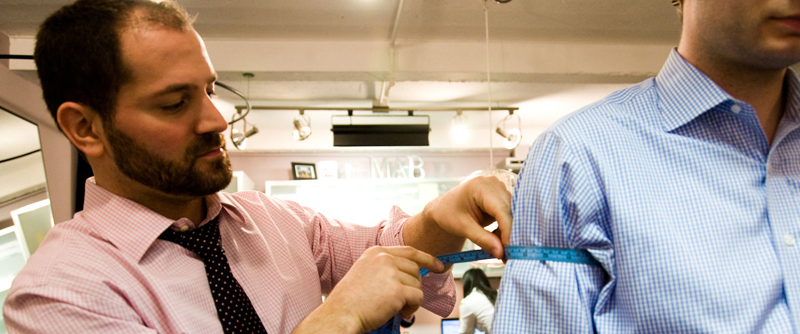Michael Mantegna has an alluring presence. He is well built, and almost looks like he could be Tom Ford’s younger brother. Perhaps not surprisingly, Mantegna counts Ford as one of his style icons.
“He’s a good-looking guy and what he recognizes is that he wants his clothes to compliment him,” he said. “Someone like Tom Ford walks out into the world with a great level of confidence and his clothes reflect that. I think a lot of guys identify with that.” Mantegna speaks clearly and with self-assurance and knows when to stop. When hearing his voice back through my tape recorder, there were few ums and pauses. He has a thick face, but in a good way, and he certainly doesn’t look the way I expected a tailor to look—I’d envisioned a bespectacled man sitting cross-legged, hand-sewing a garment with measuring tape wrapped around his neck.
In an industry where old-world tailoring techniques are revered and where tailors who have been making the same type of suit practically since before sliced bread argue over what type of shoulder is proper, Mantegna is a tailor for a new generation. He offers his clients a more contemporary-fitting suit. The pants are usually cut in the style of low-rise jeans, and things in general are a little bit tighter, accentuating a client’s best features but sometimes also highlighting their not-so-good ones.
The “Andrews” in Michael Andrews Bespoke, stands for Mantegna’s partner—Andrew Wells, who helped start the business. Both men worked as lawyers and traveled often. On trips abroad they discovered a quick service that Americans seldom consider—custom tailoring. “I started getting my suits made overseas when we would travel,” Mantegna said. “After dragging Andrew through tailor shops and fabric markets on half a dozen trips, he commented that I should try to start my own business because I enjoyed this so much.” Wells doesn’t work for the company any more, but Mantegna calls him his “coach and mentor,” and will often call him when he needs sound advice.
After working as a lawyer in London, Mantegna, who is originally from Atlanta, returned to New York, took a men’s tailoring class at the Fashion Institute of Technology and started Michael Andrews. He continued to practice law, and work on the company on the side, until, he said, “the ship needed a captain. I left when it made economic sense.”
It may be surprising that someone who worked on revising contracts for eight years could switch gears so drastically, but Mantegna said that his ambition was right there from the beginning. “I’ve always been an entrepreneur at heart. As much as I enjoyed being a lawyer, it was never as fulfilling as creating your own company and really building something from the ground up.”
A Michael Andrews suit takes six to eight weeks to complete. A client will come in, and Mantegna or his head designer, Clark Shaw, 24, will sit down and talk with him about what he’s looking for, and what kinds of clothes are in his wardrobe now. “We try to offer some honest, helpful, fashion advice,” said Mantegna. Then they’ll help the client pick out fabric from the hundreds of swatches in their fabric books. “We hold their hand through the selection process,” Mantegna said. After that, Mantegna takes the measurements—shoulder width, arm length, the size of the bicep, inseam, waist measurement, etc. They also take photos of the client from the side and straight on. Someone will then type up these measurements and send them online to their tailoring place in China. A finished garment will arrive by air in four weeks. The client will come in again for a final in-house fitting and fine-tuning.
At face value, this regime may seem a little strange—and indeed it is different from the way other upper-echelon New York tailoring companies operate. Many of them produce suits on site, literally adjacent to the showroom where a client’s measurements are taken. Others send their orders to London for sewing on prestigious Savile Row. But Mantegna insists that the quality of his suits does not suffer by their being made in China. That also, of course, contains the cost. A regular Michael Andrews suit costs about $1,200. A three-button Armani suit from Neiman Marcus costs $1,700 and may fit okay, but a custom suit, many suggest, will cost less and fit better. Plus you can get those pink buttonholes you’ve been dreaming about.

